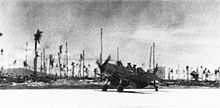Munda Airport
| Munda Airport | |||||||||||
|---|---|---|---|---|---|---|---|---|---|---|---|
| IATA: MUA – ICAO: AGGM | |||||||||||
| Summary | |||||||||||
| Location | Munda, New Georgia island | ||||||||||
| Elevation AMSL | 10 ft / 3 m | ||||||||||
| Coordinates | 08°19′40.69″S 157°15′47.13″E / 8.3279694°S 157.2630917°E | ||||||||||
| Runways | |||||||||||
| |||||||||||
Munda Airport is an airport in Munda on New Georgia Island in the Solomon Islands (IATA: MUA, ICAO: AGGM).
Airlines and destinations
| Airlines | Destinations |
|---|---|
| Solomon Airlines | Gizo, Seghe |
History
World War II

A Japanese directive in late October 1942 called for an air base to be built at Munda Point, about 150 miles (240 km) northwest of Guadalcanal and Henderson Field.
Construction began in mid-November with a great emphasis on keeping the forward airfield secret. The majority of airfield work done before clearing the main runway and surfacing it with crushed coral. By wiring the tops of palm trees to keep them in place, allowing work to initially escape detection. Finally the trunks were cut away, and runway completed.
Despite these efforts, reports of the strip were relayed to Guadalcanal via coastwatcher Danny Kennedy and aerial reconnaissance spotted increased barge traffic and evidence of crushed coral being prepared at the strip, but the Japanese succeeded in buying enough time to complete a single 1,094 feet (333 m) by 44 feet (13 m) all weather runway for fighters operational on 17 December 1942.
Opened on 1 December 1942, it was used by the Japanese Navy and Japanese Army Air Force as a forward operating base. As soon as it was operational, the airfield was hampered by the observation of coastwatchers in the area, including Kennedy and D.C. Horton who was observing the airfield from Rendova. It was heavily bombed from the air by the Allies prior to the American landing.
Munda airfield was the principal objective of the Central Solomons campaign, also known as Munda or Munda Point Airfield. It was captured by the US Army XIV Corps forces after 12 continuous days of fierce fighting in the jungle area. The high ground around the airfield fell on August 5, 1943.
Once seized, the Americans improved and expanded the airbase for their own operations. The first American aircraft landed at Munda on August 14, 1943 with landings by F4U Corsairs piloted by Robert Owen of VMF-215, a 44th Fighter Squadron (44th FS) P-40 Warhawk and a J2F Duck with Marine Brigadier General Francis P. Mulcahy aboard.
Known American air units stationed at Munda Airfield were:
|
|

Postwar
After the war, the airfield was turned into a commercial airport, used for regional flights by Solomon Airlines.
See also
References
![]() This article incorporates public domain material from websites or documents of the Air Force Historical Research Agency.
This article incorporates public domain material from websites or documents of the Air Force Historical Research Agency.
- Maurer, Maurer (1983). Air Force Combat Units Of World War II. Maxwell AFB, Alabama: Office of Air Force History. ISBN 0-89201-092-4.
- Maurer, Maurer, ed. (1982) [1969]. Combat Squadrons of the Air Force, World War II (PDF) (reprint ed.). Washington, DC: Office of Air Force History. ISBN 0-405-12194-6. LCCN 70605402. OCLC 72556.
External links
| |||||||||||||||||||||||||||||||||||||||||||||||||||||||||||
.jpg)